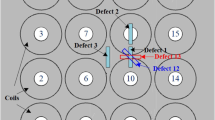Abstract
Magnetic Induction Tomography (MIT) is a contactless and non-invasive method that is sensitive to the conductivity properties of an object. The application of the MIT in the biomedical field is in high demand, especially for brain monitoring and tumour imaging. However, the implementation of MIT for bone imaging application is not popular. In this paper, the performance of MIT for bone imaging is studied. The objective of this paper is to study the eddy current distribution for the bone with varying shape, size and location. The conductivity of the other tissue also will be considered to see its effect on the eddy current distribution. The model in this paper used one excitation coil of the 10 AWG copper wire with 10 turns. The frequency and current used in this study are 1 MHz and 1 A. The results show that the eddy current analysis able to detect the different shape, size and location of the bone. The eddy current density of the bone is 0.509 A/m2 for the size of 1 cm, which located at the centre of ROI. The value increases when the size of the bone is bigger and located near the transmitter coil. It also shows that the conductivity of the tissue affects the eddy current distribution.
Access this chapter
Tax calculation will be finalised at checkout
Purchases are for personal use only
Similar content being viewed by others
References
Luo H, Jiang X (2016) The magnetic induction tomography measurement system based on Helmholtz coil. In: Proceedings—2015 8th international conference on biomedical engineering and informatics BMEI 2015, no Bmei, pp 29–33
Xiao Z, Tan C, Dong F (2017) Effect of inter-tissue inductive coupling on multi-frequency imaging of intracranial hemorrhage by magnetic induction tomography. Meas Sci Technol 28(8)
Wang L (2018) Three-dimensional holographic electromagnetic imaging for accessing brain stroke. Sensors 18(11)
Wubuli S, Roula A, Mamatjan Y (2018) Rapid estimation of object movements in magnetic induction tomography. Int J Biomed Eng Technol 27(4):290
Ma L, Banasiak R, Soleimani M (2016) Magnetic induction tomography with high performance GPU implementation. Prog Electromagn Res B 65(1):49–63
Al-Hawari M, Aulia AI, Rudin A, Rohmadi, Muttakin I, Taruno WP (2018) Receiver circuit design for signal conditioning in magnetic induction tomography system. In: Proceedings 2017 5th international conference on instrumentation, communications, information technology, and biomedical engineering ICICI-BME 2017, Nov, pp 230–235
Ma L, Soleimani M (2017) Magnetic induction tomography methods and applications: a review. Meas Sci Technol 28(7)
Oziel M, Korenstein R, Rubinsky B (2018) Non-contact monitoring of temporal volume changes of a hematoma in the head by a single inductive coil: a numerical study. IEEE Trans Biomed Eng, 1
Griffith J et al (2018) Non-invasive electromagnetic skin patch sensor to measure intracranial fluid-volume shifts. Sensors 18(4):1–17
Hopfer M, Planas R, Hamidipour A, Henriksson T, Semenov S (2017) Electromagnetic tomography for detection, differentiation, and monitoring of brain stroke: a virtual data and human head phantom study. IEEE Antennas Propag Mag 59(5):86–97
Semenov S, Hopfer M, Planas R, Hamidipour A, Henriksson T (2017) Electromagnetic tomography for brain imaging: 3D reconstruction of stroke in a human head phantom. In: 2016 IEEE conference on antenna measurements and applications CAMA 2016, pp 1–4
Wang L, Al-Jumaily AM (2017) Imaging of lung structure using holographic electromagnetic induction. IEEE Acc 5
Deans C, Marmugi L, Hussain S, Renzoni F (2016) Optical atomic magnetometry for magnetic induction tomography of the heart. Quantum Opt 9900:99000F
Lloyd BA, Dielectric properties. Available: https://itis.swiss/virtual-population/tissue-properties/database/dielectric-properties/
Ann HJ, Su-Shi LS, Zakaria Z (2017) Non-invasive breast cancer assessment using magnetic induction spectroscopy technique. Int J Integr Eng 9(2):54–60
Acknowledgements
The authors would like to thank the Ministry of Higher Education (MOHE) through Fundamental Research Grant Scheme (FRGS/1/2018/TK03/UNIKL/02/2) for providing the financial support and System Engineering and Energy Laboratory (SEELab) for the guidance of this project.
Author information
Authors and Affiliations
Corresponding author
Editor information
Editors and Affiliations
Rights and permissions
Copyright information
© 2021 The Author(s), under exclusive license to Springer Nature Singapore Pte Ltd.
About this chapter
Cite this chapter
Isamail, L., Abu Bakar, M.H. (2021). Finite Element Model of Magnetic Induction Tomography for Low Conductivity Sample. In: Akhyar (eds) Proceedings of the 2nd International Conference on Experimental and Computational Mechanics in Engineering. Lecture Notes in Mechanical Engineering. Springer, Singapore. https://doi.org/10.1007/978-981-16-0736-3_5
Download citation
DOI: https://doi.org/10.1007/978-981-16-0736-3_5
Published:
Publisher Name: Springer, Singapore
Print ISBN: 978-981-16-0735-6
Online ISBN: 978-981-16-0736-3
eBook Packages: EngineeringEngineering (R0)




